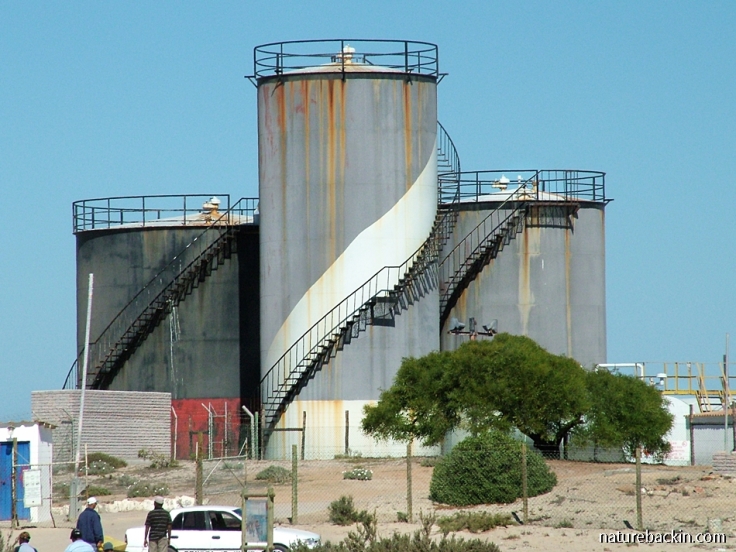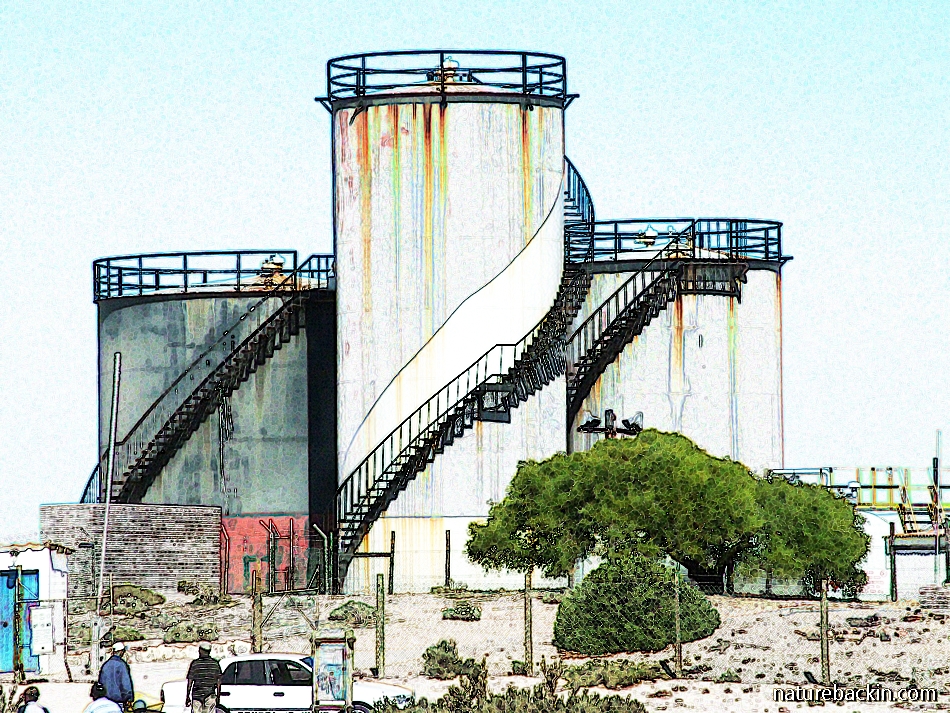The small town of Port Nolloth’s history is centred on what used to be called “nature’s bounty”, specifically the exploitation of seals, then copper and then diamonds.
The first small settlement was established back in the late 1700s, the attraction being a nearby Cape Fur Seal colony. The bay was then named Robbe Baai (Seal Bay) and large numbers of seals were killed for their pelts and the meat (dried for export) and oil that their bodies provided. For a sobering assessment of the slaughter of seals including the extinction of 23 breeding colonies in the Cape in the 300-year period, 1600 to 1899, see here.
In the 1850s the renamed Port Nolloth established a port for the export of copper mined from further inland, with a narrow gauge railway line opened in 1876 to transport the copper from the mines to the port. The railway operated until 1942, after which copper was transported by road. Copper mining in Namaqualand has declined significantly and no large mining companies operate in the area currently.
In 1925 the first alluvial diamonds were discovered offshore. Today, although reserves are depleted, the seabed is still dredged for diamonds. Port Nolloth remains a base for the small diamond boats and attendant divers that relentlessly dredge the seabed, sucking up everything on the ocean floor, in their quest for diamonds. For an interesting take on their endeavours see here.
Nowadays fishing, particularly for crayfish, remains a mainstay of the town’s economy. The fuel tanks in the photograph stand as an unacknowledged monument to all this activity; with the seals, copper and diamonds gone or depleted and fish stocks also diminishing, hopefully small-seaside-town tourism will provide continuing income in a town where one of the most notable attractions is a museum dedicated to its past.
The photo of the storage tanks above I edited using PhotoScape to achieve a more sculptural effect. The original photo is below.

Posted by Carol









January 23, 2019 at 5:42 am
Nice post and amazing pictures.
Do take part in this challenge – https://mesmotsbysazz.com/2019/01/23/no-words-wednesday-challenge-4/
LikeLiked by 1 person
January 23, 2019 at 1:36 pm
Thank you Sajal. The no words Wednesday challenge looks interesting.
LikeLike
January 23, 2019 at 1:43 pm
Thanks!! Looking ahead for your participation!
Share this with your photographer friends too 🙂
LikeLiked by 1 person
December 1, 2018 at 5:16 am
I like the photo edit. It gives the photo an ‘artist’s rendition’ appearance. I like, too, the brief history of the town. In some ways it could be anywhere in the world since it seems like every country has towns that boomed at some point, then faded once they’d exhausted whatever bounty was being exploited.
LikeLiked by 1 person
December 1, 2018 at 5:31 am
Thanks Graham and good to know that you like the photo edit. I suppose the universal boom and bust scenario of many towns demonstrates what is meant by unsustainable.
LikeLiked by 1 person
November 30, 2018 at 3:28 pm
The reduced effects of PhotoScape are brilliant!
LikeLiked by 1 person
December 1, 2018 at 5:11 am
Thank you Simone. PhotoScape can be downloaded for free and has many useful and easy-to-use features.
LikeLiked by 1 person
November 30, 2018 at 10:53 am
What an arresting slice of the past, Carol. A catalogue of exploitation, and then that stark image of small diamond boats still going out to dredge depleted diamond reserves – still in hopes!
LikeLiked by 1 person
November 30, 2018 at 2:35 pm
Some have few alternatives I guess and there are enough stories of lucky finds to keep them going.
LikeLiked by 1 person
November 30, 2018 at 3:11 pm
I can imagine those hopes!
LikeLiked by 1 person
November 30, 2018 at 4:24 am
An interesting overview.
LikeLiked by 1 person
November 30, 2018 at 5:45 am
Thanks Anne. It still seems to style itself as a pioneer settlement.
LikeLike
November 30, 2018 at 4:07 am
Very cool photo editing. Exploitation is the name of the game. We live not far from a designated wilderness that the current clown in the White House is trying to open to mining. It would affect our watershed, not to mention the salmon and trout fishing. There doesn’t seem to be any end in sight.
LikeLiked by 1 person
November 30, 2018 at 5:37 am
The assault on the little wilderness that remains is starkly real when in one’s own neighbourhood. I hope that sense prevails and your protected area remains protected even in the face of short-sighted self interest.
LikeLiked by 1 person
November 30, 2018 at 9:24 pm
Our latest election offers some bits of hope.
LikeLiked by 1 person
November 30, 2018 at 12:27 am
This story is repeated the world over: wherever there is something to be exploited, humans have done and still do.
I very much like your altered version of the photo: it has an interesting etched effect.
LikeLiked by 1 person
November 30, 2018 at 5:27 am
Yes it is a familiar story and sadly so. It seems that even this fragile planet is not enough for our rapacious ways.
Thanks very much for the feedback on the photo.
LikeLiked by 1 person
November 29, 2018 at 10:01 pm
Hmm. We seem to have a long way to go before we learn that every damn’ thing isn’t ours for the taking. Great edited photo!
LikeLiked by 1 person
November 30, 2018 at 5:18 am
Thank you Margaret. A long way to go indeed. This post turned out gloomier (and longer!) than intended. Hard not to hit a bummer every now and again …
LikeLiked by 1 person
November 30, 2018 at 9:00 am
We all need reminding to do what we can, however little that is.
LikeLiked by 1 person
November 30, 2018 at 2:31 pm
🙂
LikeLiked by 1 person
November 29, 2018 at 9:48 pm
I wish it wasn’t so, but it seems the story of man largely is the story of exploitation.
LikeLiked by 1 person
November 30, 2018 at 5:10 am
Sadly so.
LikeLike
November 29, 2018 at 9:20 pm
When I saw your first image it really intrigued me and I wondered what you’d done. Then I was so happy when you showed the original and explained the difference. I usually prefer an original to an edited version but what you’ve done is magnificent – I really like the simplicity and structure of your first image!
LikeLiked by 1 person
November 30, 2018 at 5:08 am
Thanks so much for the feedback Liz – I am interested to know that you like the altered image. All I did was apply the ‘watercolour pencil’ pictorial effect (using PhotoScape), which is one of the few such effects that I think can bring an interesting dimension to a photo.
LikeLiked by 1 person